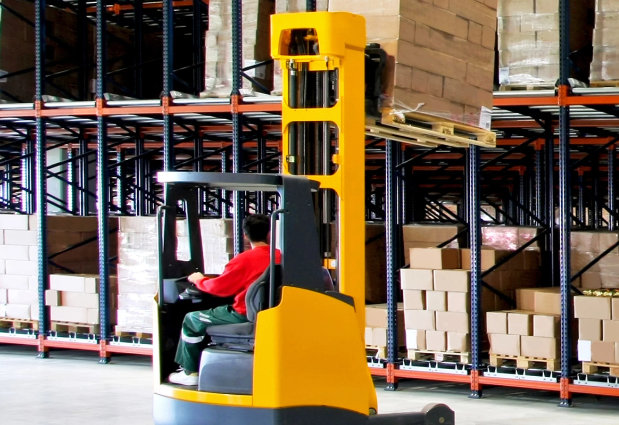Technical Blog
Major Operators Are Converting Forklift Fleets to Fuel Cell Technology

Fuel cell technology is much more than a passing fad for commercial operations. It’s a technology that has proven that material-handling vehicles can be greener, more productive and more cost-efficient. In fact, over the next few years, the demand for fuel cell technology is expected to grow by double digits, with the greatest demand being driven by industries in North America, Europe and Asia Pacific.
Proton exchange membrane type fuel cells made up about 46.3 percent of the demand for fuel cells in 2011. PEMFCs operate at a low temperature (80 to 200 degrees Fahrenheit) relative to other fuel cell types and are capable of handling sudden shifts in power output, making them ideal for powering the acceleration in cars and specialty vehicles, like forklifts, according to the Fuel Cell & Hydrogen Energy Association (Washington, D.C., fchea.org).
More than 4,000 fuel cell-powered forklifts were used in U.S. material handling operations in 2013. Some of the country’s best known brands, including Sysco Foods, FedEx Freight, Walmart, Lowe’s, Proctor & Gamble and Coca-Cola, are convinced by the data that lift trucks driven by fuel cells instead of batteries generate a bigger payback and offer streamlined efficiencies in their operations. These are good reasons for the trend to continue.
Transparency Market Research forecasts the global fuel cell market to grow at a strong annual compound growth rate of 15 percent from 2013 to 2018. At this rate, in U.S. dollars, fuel cell demand will be worth $910.3 million in 2018, up from $355.3 million in 2011. While the Asia Pacific and North America regions create the greatest demand for fuel cell technology, Europe could be the most promising market in the near future. (Ref. “Fuel Cells Market – Global Industry Analysis, Size, Share, Trends, Analysis, Growth and Forecast, 2012–2018,” by TMR).
So, what is driving this rapidly increasing demand for hydrogen fuel cells?
Fuel cell-powered forklift fleets offer a favorable combination of business benefits plus government support for environmental sustainability that is quickly making battery-operated forklift fleets seem obsolete:
Hydrogen fuel cells can be retrofitted into existing forklift trucks in the space required by lead batteries, avoiding burdensome replacement of existing capital equipment.
Small-footprint hydrogen refueling stations can easily integrate into the existing infrastructure space. The elimination of spare battery storage areas, necessary for battery-powered fleets, frees-up precious warehouse floor space.
Time saved by eliminating battery recharging and change-outs results in about two to five percent net productivity gains. Hydrogen-powered vehicles are quickly refueled at conveniently located fueling stations in just five minutes or less. In addition, hydrogen fuel cell systems can replace redundant battery and generator systems with up to 52 hours of runtime in the case of a power outage.
In contrast to the byproducts produced by batteries, the hydrogen fuel systems produce electricity, excess heat and water, resulting in significantly lower greenhouse emissions for the company converting to a fleet of fuel cell-powered forklifts and backup power systems. This is good news for governments promoting regulations to reduce greenhouse gasses.
Bright Outlook for Hydrogen Fuel Cell Technology
The demand for PEMFCs is expected to grow at a CAGR of 11.5 percent from 2013 to 2018. The demand for molten carbonate fuel cells, used mainly for stationary power generation, is expected to grow at a CAGR of 17.8 percent during the same period. MCFC accounted for 39.2 percent of the total demand in 2011, but at this forecasted growth rate it should surpass the demand for PEMFC.
From a global perspective, fuel cell technology is currently more dominant in North America due to regulatory support, governmental acceptance and the aggressive technological innovation push seen in recent times. The U.S. is expected to emerge as one of the biggest markets for fuel cell vehicles by 2018. Asia Pacific is the other major region where the fuel cell market is very strong with demand expected to grow at a CAGR of about 12 percent from 2013 to 2018. Based on the strong push for sustainability and regulatory policies, Europe is expected to grow at the highest rate among these three major regions.
In terms of impact to industry, according to a study published by the U.S. Department of Energy, as more organizations shift from battery-powered lift trucks to hydrogen fuel cell technology, the supply chain supporting the industry is expected to grow at a CAGR of about 15 percent.
About the Author
HandyTube Corporation, a Handy & Harman Company, is a premium manufacturer of long-length hydrogen tubing. HandyTube’s seamless, stainless steel coils are also used in applications for the oil and gas, chemical process, shipbuilding, instrumentation, aerospace and defense, process automation and life sciences industries. A recent corporate focus is to expand its proven long-length hydrogen tubing into the hydrogen fuel cell market.
You can contact HandyTube at +1 302.697.9521
Content sources include Plug Power.







